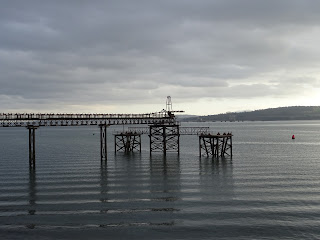I often walk or cycle along the old railway paths that crisscross Edinburgh. If I’m heading down to Newhaven I’ll take the Trinity Path, which goes through the damply fascinating Trinity Tunnel or East Trinity Road Railway Tunnel to give it its full name. The tunnel and the path were once part of the Edinburgh, Leith and Granton Railway which operated from around 1840 until 1986.
The tunnel is 390 feet long and passes
under East Trinity Road and several houses.
It has a horseshoe opening and is constructed of sandstone, and have I mentioned it is very, very
damp? Water oozes down the walls
resulting in some fascinating crumbling grooves, rust coloured mud and lots of
mini stalactite type blobs. Some of the oozing,
dissolving stone looks almost soft and as if it is an organic, living thing. A weird alien life form escaping from the
hewn rocks that were used to build the structure.
Multicoloured slime and ooze
From late spring onwards the dark
cavities and grooves of the oozing stone are occupied by thousands of little spiders
who hang from thin threads waiting for their prey…or any inquisitive
arachnophobes who get too close.
I left the Skulferatu that accompanied
me on my walk in a small cavity of rusting, dripping slime where it will
hopefully be consumed into the melting walls of the tunnel.
The coordinates for the location of the
Skulferatu are –
Latitude 55.976781
Longitude -3.203583
I used the following sources for information
on the tunnel -
Historic Environment
Scotland
East Trinity Road
Railway Tunnel, Edinburgh
Rail Scot
.JPG)
.JPG)
.jpg)
.jpg)
.jpg)
.jpg)
.JPG)
.jpg)
.JPG)
.jpg)
.jpg)
.JPG)
.JPG)
.JPG)
.JPG)
.JPG)
.JPG)
.JPG)
.JPG)
.jpg)
.jpg)



















